Temperature-Dependent Hydrogen Embrittlement of Austenitic Stainless Steel on Phase Transformation
Abstract
1. Introduction
2. Materials and Methods
3. Results and Discussion
3.1. Stress-Strain Relationship
3.2. Mechanical Characteristics
3.3. Hydrogen Index
3.4. Fracture Surface
4. Concluding Remarks
- From the EBSD observation, nonprestrained SUS304L testing samples with austenitic phase showed insignificant effects of hydrogen charging.
- In the stress–strain relationship with hydrogen charging, the prestrain temperature affected the reduction in elongation. In contrast, the experimental temperature affected the general shape of the stress–strain relationship.
- The CR20(H) case, which involves 20% prestraining at cryogenic temperature followed by testing at room temperature, showed the most extreme results, with fracture in the elastic region owing to hydrogen embrittlement.
- In all cases, the yield strength increased, whereas the tensile strength and elongation decreased owing to hydrogen charging.
- The hydrogen index, which represents the hydrogen susceptibility of metallic materials, was proposed. Using it, the temperatures and degree of prestrain considered hydrogen index can be available.
- Transgranular fractures, flat facets, and secondary cracks on the edges were observed in the samples with hydrogen charging. In addition, dimples, which are a primary indicator of ductile fracture, were observed at the center of the fracture surfaces in all specimens, except for CR20.
Author Contributions
Funding
Institutional Review Board Statement
Informed Consent Statement
Data Availability Statement
Conflicts of Interest
References
- Durbin, D.J.; Malardier-Jugroot, C. Review of Hydrogen Storage Techniques for on Board Vehicle Applications. Int. J. Hydrogen Energy 2013, 38, 14595–14617. [Google Scholar] [CrossRef]
- Pan, C.; Chu, W.Y.; Li, Z.B.; Liang, D.T.; Su, Y.J.; Gao, K.W.; Qiao, L.J. Hydrogen Embrittlement Induced by Atomic Hydrogen and Hydrogen-Induced Martensites in Type 304L Stainless Steel. Mater. Sci. Eng. A 2003, 351, 293–298. [Google Scholar] [CrossRef]
- Zhang, H.; Huang, C.; Huang, R.; Li, L. Influence of Pre-Strain on Cryogenic Tensile Properties of 316LN Austenitic Stainless Steel. Cryogenics 2020, 106, 103058. [Google Scholar] [CrossRef]
- Michler, T.; Naumann, J.; Hock, M.; Berreth, K.; Balogh, M.P.; Sattler, E. Microstructural Properties Controlling Hydrogen Environment Embrittlement of Cold Worked 316 Type Austenitic Stainless Steels. Mater. Sci. Eng. A 2015, 628, 252–261. [Google Scholar] [CrossRef]
- Talonen, J.; Nenonen, P.; Pape, G.; Hänninen, H. Effect of Strain Rate on the Strain-Induced-Martensite Transformation and Mechanical Properties of Austenitic Stainless Steels. Metall. Mater. Trans. A 2005, 36, 421–432. [Google Scholar] [CrossRef]
- Datta, K.; Delhez, R.; Bronsveld, P.M.; Beyer, J.; Geijselaers, H.J.M.; Post, J. A Low-Temperature Study to Examine the Role of ε-Martensite during Strain-Induced Transformations in Metastable Austenitic Stainless Steels. Acta Mater. 2009, 57, 3321–3326. [Google Scholar] [CrossRef]
- Lee, W.S.; Lin, C.F. Effects of Prestrain and Strain Rate on Dynamic Deformation Characteristics of 304L Stainless Steel: Part 2—Microstructural Study. Mater. Sci. Technol. 2002, 18, 877–884. [Google Scholar] [CrossRef]
- Sayed, A.M.; Alanazi, H. Performance of Steel Metal Prepared using Different Welding Cooling Methods. Case Stud. Constr. Mater 2022, 16, e00953. [Google Scholar] [CrossRef]
- Nam, Y.H.; Park, J.S.; Baek, U.B.; Suh, J.Y.; Nahm, S.H. Low-Temperature Tensile and Impact Properties of Hydrogen-Charged High-Manganese Steel. Int. J. Hydrogen Energy 2019, 44, 7000–7013. [Google Scholar] [CrossRef]
- Wang, Y.; Wu, X.; Wu, W. Effect of A’ Martensite Content Induced by Tensile Plastic Prestrain on Hydrogen Transport and Hydrogen Embrittlement of 304L Austenitic Stainless Steel. Metals 2018, 8, 660. [Google Scholar] [CrossRef]
- Perng, T.; Altste-M’er, J. Effects of Deformation on Hydrogen Permeation in Austenitic Stainless Steels. Acta Metall. 1986, 34, 1771–1781. [Google Scholar]
- Wang, Y.; Wang, X.; Gong, J.; Shen, L.; Dong, W. Hydrogen Embrittlement of Catholically Hydrogen-Precharged 304L Austenitic Stainless Steel: Effect of Plastic Pre-Strain. Int. J. Hydrogen Energy 2014, 39, 13909–13918. [Google Scholar] [CrossRef]
- Wang, Y.; Zhou, Z.; Wu, W.; Gong, J. Warm Pre-Strain: Strengthening the MetasTable 304L Austenitic Stainless Steel without Compromising Its Hydrogen Embrittlement Resistance. Materials 2017, 10, 1331. [Google Scholar] [CrossRef] [PubMed]
- Ueki, S.; Koga, K.; Mine, Y.; Takashima, K. Crystallographic Characterisation of Hydrogen-Induced Twin Boundary Separation in Type 304 Stainless Steel Using Micro-Tensile Testing. ISIJ Int. 2019, 59, 927–934. [Google Scholar] [CrossRef]
- Zhang, L.; Li, Z.; Zheng, J.; Zhao, Y.; Xu, P.; Zhou, C.; Li, X. Effect of Strain-Induced Martensite on Hydrogen Embrittlement of Austenitic Stainless Steels Investigated by Combined Tension and Hydrogen Release Methods. Int. J. Hydrogen Energy 2013, 38, 8208–8214. [Google Scholar] [CrossRef]
- Wang, Y.; Wu, X.; Li, X.; Wu, W.; Gong, J. Combined Effects of Prior Plastic Deformation and Sensitization on Hydrogen Embrittlement of 304 Austenitic Stainless Steel. Int. J. Hydrogen Energy 2019, 44, 7014–7031. [Google Scholar] [CrossRef]
- Zhou, C.; Song, Y.; Shi, Q.; Hu, S.; Zheng, J.; Xu, P.; Zhang, L. Effect of Pre-Strain on Hydrogen Embrittlement of Metastable Austenitic Stainless Steel under Different Hydrogen Conditions. Int. J. Hydrogen Energy 2019, 44, 26036–26048. [Google Scholar] [CrossRef]
- Kim, Y.S.; Bak, S.H.; Kim, S.S. Effect of Strain-Induced Martensite on Tensile Properties and Hydrogen Embrittlement of 304 Stainless Steel. Metall. Mater. Trans. A Phys. Metall. Mater. Sci. 2016, 47, 222–230. [Google Scholar] [CrossRef]
- Wang, Y.; Gong, J.; Jiang, Y.; Jiang, W.; Jiang, W. Ductility Loss of Hydrogen-Charged and Releasing 304L Steel. Front. Mech. Eng. 2013, 8, 298–304. [Google Scholar] [CrossRef]
- Borchers, C.; Michler, T.; Pundt, A. Effect of Hydrogen on the Mechanical Properties of Stainless Steels. Adv. Eng. Mater. 2008, 10, 11–23. [Google Scholar] [CrossRef]
- Pinto, H.; Pyzalla, A.R.; Hübner, W.; Mus, K.A. Influence of Environment, Temperature and Chemical Composition on the Microstructural Deterioration of CrNi Steels during Friction. Materwiss Werksttech 2004, 35, 716–721. [Google Scholar] [CrossRef]
- San Marchi, C.; Somerday, B.P.; Tang, X.; Schiroky, G.H. Effects of Alloy Composition and Strain Hardening on Tensile Fracture of Hydrogen-Precharged Type 316 Stainless Steels. Int. J. Hydrogen Energy 2008, 33, 889–904. [Google Scholar] [CrossRef]
- Spencer, K.K.; Véron, M.; Zhang, Y.; Embury, J.D. The Strain Induced Martensite Transformation in Austenitic Stainless Steels Part 1—Influence of Temperature and Strain History. Mater. Sci. Technol. 2009, 25, 7–17. [Google Scholar] [CrossRef]
- Li, X.; Ma, X.; Zhang, J.; Akiyama, E.; Wang, Y.; Song, X. Review of Hydrogen Embrittlement in Metals: Hydrogen Diffusion, Hydrogen Characterization, Hydrogen Embrittlement Mechanism and Prevention. Acta Metall. Sin. 2020, 33, 759–773. [Google Scholar] [CrossRef]
- Lynch, S. Discussion of Some Recent Literature on Hydrogen-Embrittlement Mechanisms: Addressing Common Misunderstandings. Corros. Rev. 2019, 37, 377–395. [Google Scholar] [CrossRef]
- Madelen, O.; Todoshchenko, I. Hydrogen Effects on Austenitic Stainless Steels and High-Strength Carbon Steels; School of Engineering, Aalto University: Helsinki, Finland, 2015; ISBN 9789526062051. [Google Scholar]
- Barrera, O.; Bombac, D.; Chen, Y.; Daff, T.D.; Galindo-Nava, E.; Gong, P.; Haley, D.; Horton, R.; Katzarov, I.; Kermode, J.R.; et al. Understanding and Mitigating Hydrogen Embrittlement of Steels: A Review of Experimental, Modelling and Design Progress from Atomistic to Continuum. J. Mater. Sci. 2018, 53, 6251–6290. [Google Scholar] [CrossRef]
- Djukic, M.B.; Zeravcic, V.S.; Bakic, G.; Sedmak, A.; Rajicic, B. Hydrogen Embrittlement of Low Carbon Structural Steel. Procedia Mater. Sci. 2014, 3, 1167–1172. [Google Scholar] [CrossRef]
- Nagumo, M. Hydrogen Related Failure of Steels—A New Aspect. Mater. Sci. Technol. 2004, 20, 940–950. [Google Scholar] [CrossRef]
- Koyama, M.; Akiyama, E.; Lee, Y.K.; Raabe, D.; Tsuzaki, K. Overview of Hydrogen Embrittlement in High-Mn Steels. Int. J. Hydrogen Energy 2017, 42, 12706–12723. [Google Scholar] [CrossRef]
- Birnbaum, H.K.; Sofronis, P. Hydrogen-Enhanced Localized Plasticity-a Mechanism for Hydrogen-Related Fracture. Mater. Sci. Eng. A 1994, 176, 191–202. [Google Scholar] [CrossRef]
- Bak, S.H.; Abro, M.A.; Lee, D.B. Effect of Hydrogen and Strain-Induced Martensite on Mechanical Properties of AISI 304 Stainless Steel. Metals 2016, 6, 169. [Google Scholar] [CrossRef]
- Bak, S.H.; Kim, S.S.; Lee, D.B. Effect of Hydrogen on Dislocation Structure and Strain-Induced Martensite Transformation in 316L Stainless Steel. RSC Adv. 2017, 7, 27840–27845. [Google Scholar] [CrossRef]
- Yoshioka, Y.; Yokoyama, K.; Sakai, J. Role of Dynamic Interactions between Hydrogen and Straininduced Martensite Transformation in Hydrogen Embrittlement of Type 304 Stainless Steel. ISIJ Int. 2015, 55, 1772–1780. [Google Scholar] [CrossRef]
- Izawa, C.; Wagner, S.; Deutges, M.; Martín, M.; Weber, S.; Pargeter, R.; Michler, T.; Uchida, H.H.; Gemma, R.; Pundt, A. Relationship between Hydrogen Embrittlement and Md30 Temperature: Prediction of Low-Nickel Austenitic Stainless Steel’s Resistance. Int. J. Hydrogen Energy 2019, 44, 25064–25075. [Google Scholar] [CrossRef]
- Hardie, D.; Butler, J.J.F. Effect of Hydrogen Charging on Fracture Behaviour of 304L Stainless Steel. Mater. Sci. Technol. 1990, 6. [Google Scholar] [CrossRef]
- Tsay, L.W.; Yu, S.C.; Huang, R.T. Effect of Austenite Instability on the Hydrogen-Enhanced Crack Growth of Austenitic Stainless Steels. Corros. Sci. 2007, 49, 2973–2984. [Google Scholar] [CrossRef]
- Wang, S.; Martin, M.L.; Sofronis, P.; Ohnuki, S.; Hashimoto, N.; Robertson, I.M. Hydrogen-Induced Intergranular Failure of Iron. Acta Mater. 2014, 69, 275–282. [Google Scholar] [CrossRef]
- Martin, M.L.; Robertson, I.M.; Sofronis, P. Interpreting Hydrogen-Induced Fracture Surfaces in Terms of Deformation Processes: A New Approach. Acta Mater. 2011, 59, 3680–3687. [Google Scholar] [CrossRef]
- Laureys, A.; Depover, T.; Petrov, R.; Verbeken, K. Microstructural Characterization of Hydrogen Induced Cracking in TRIP-Assisted Steel by EBSD. Mater. Charact. 2016, 112, 169–179. [Google Scholar] [CrossRef]
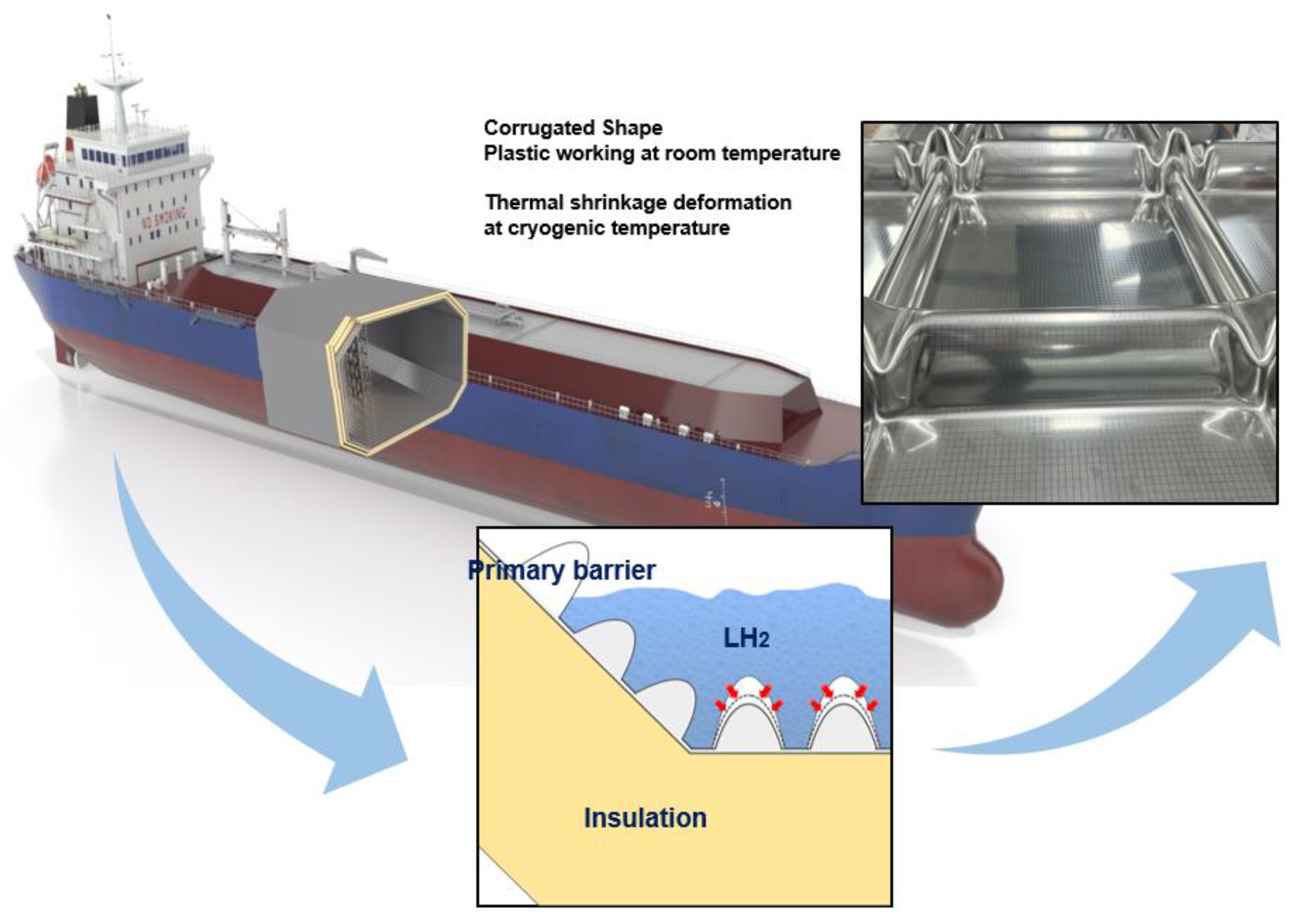

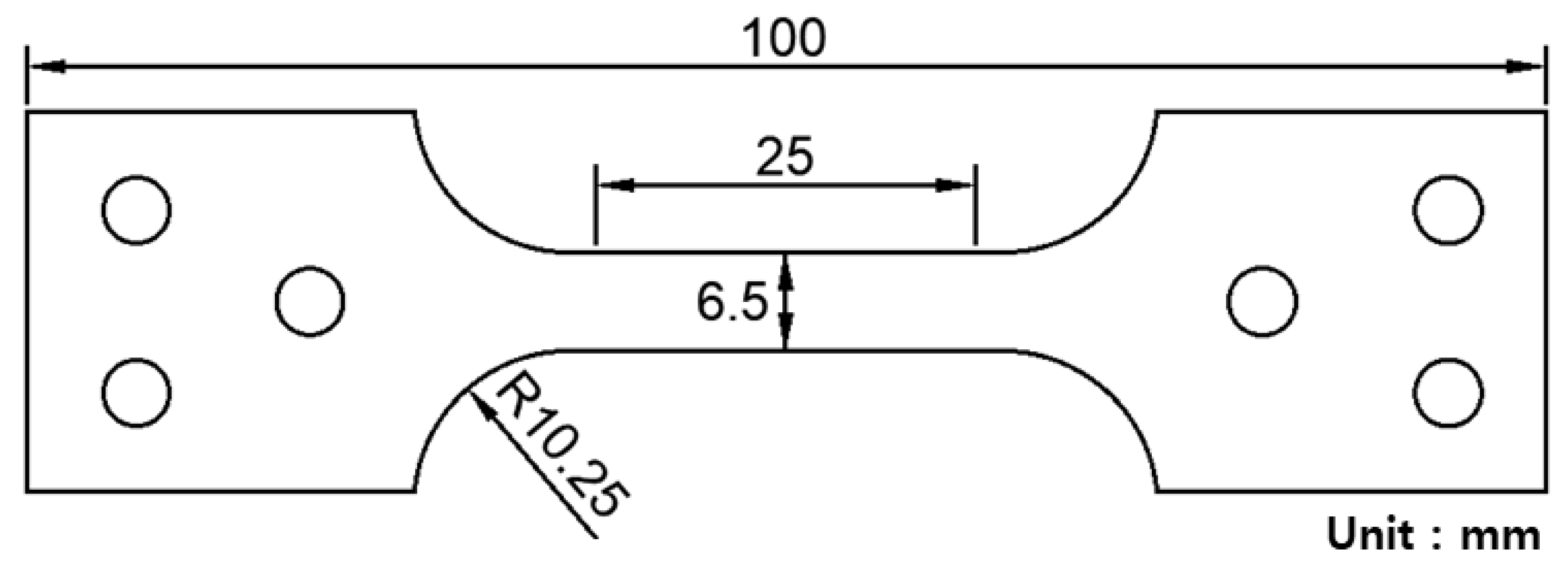

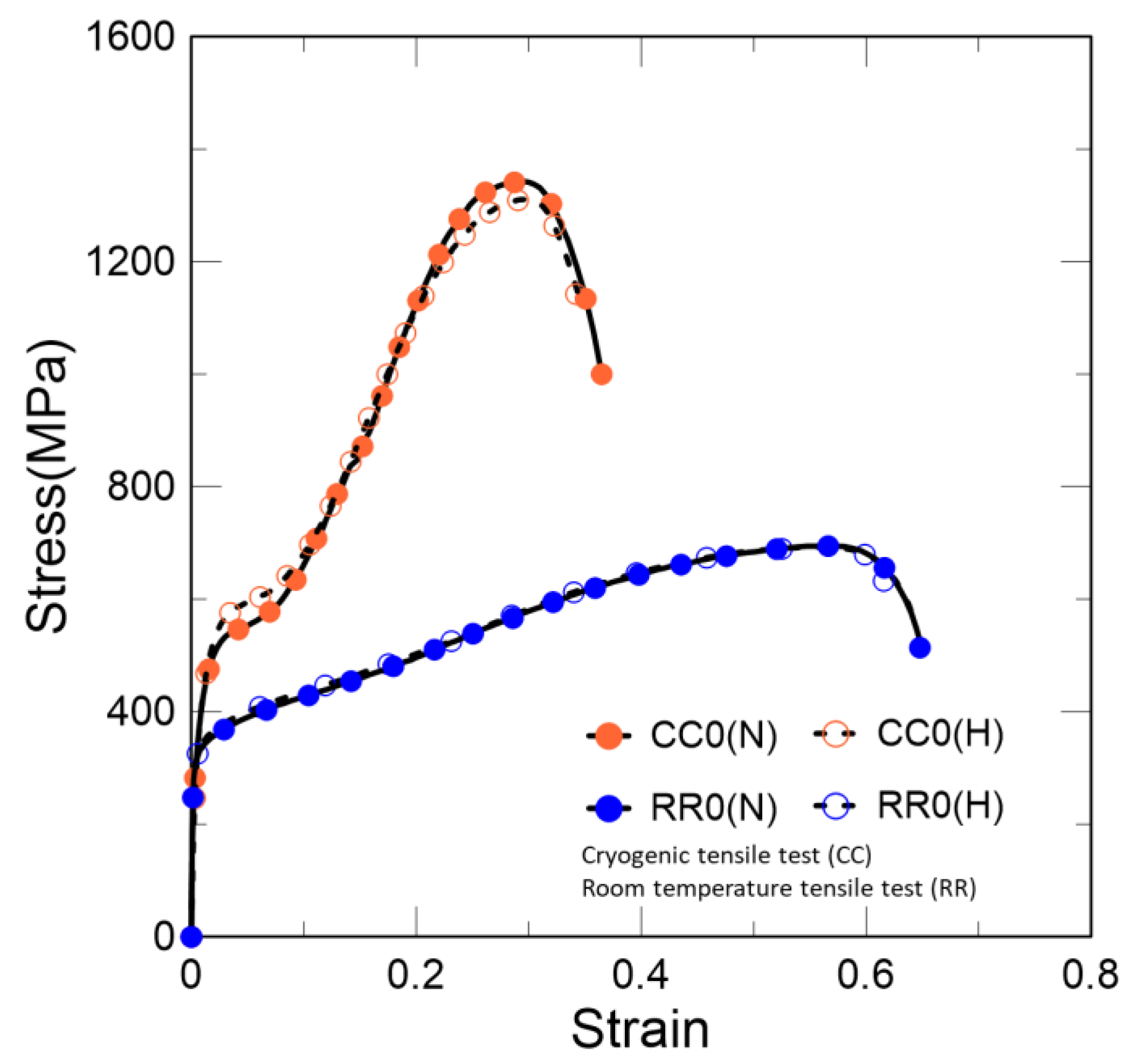
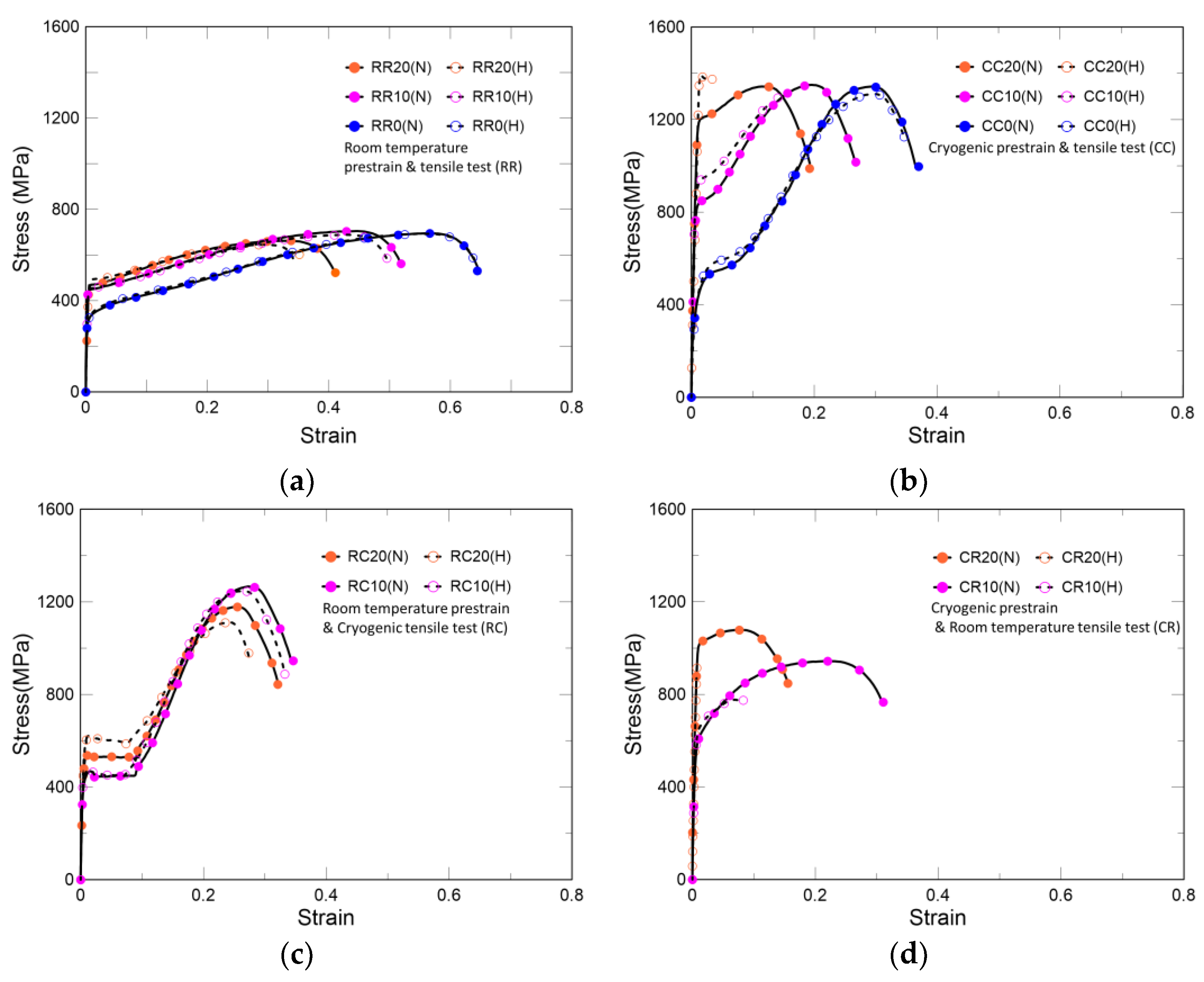
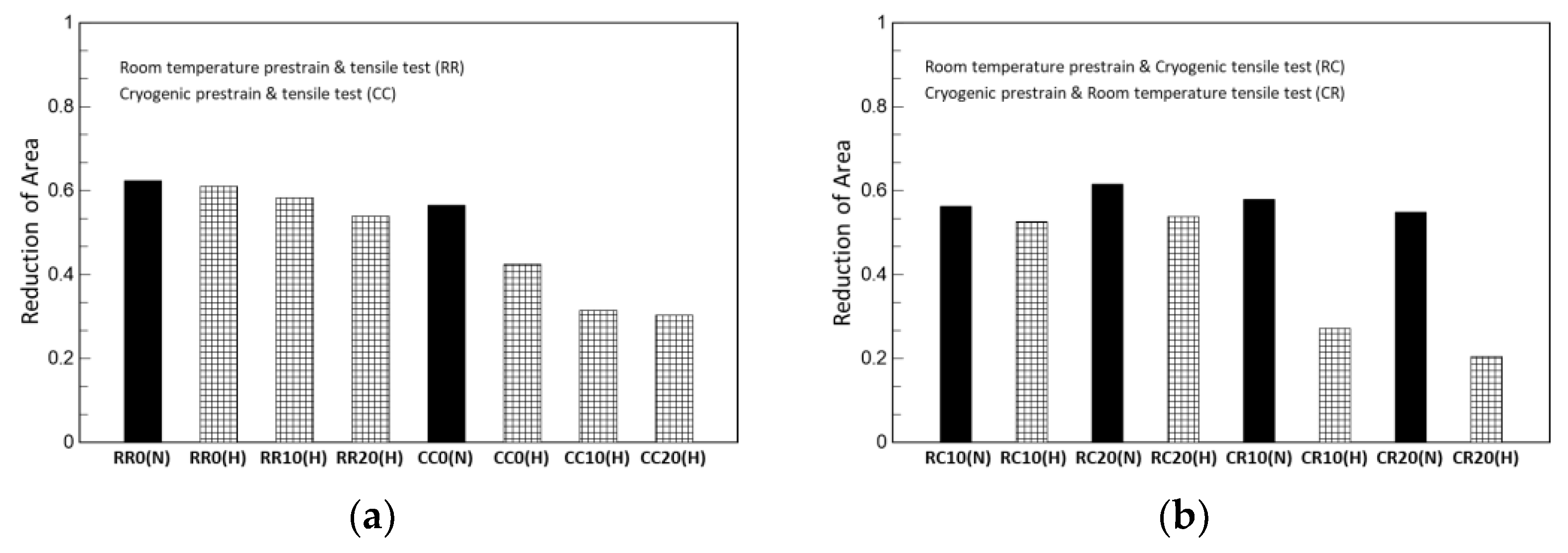
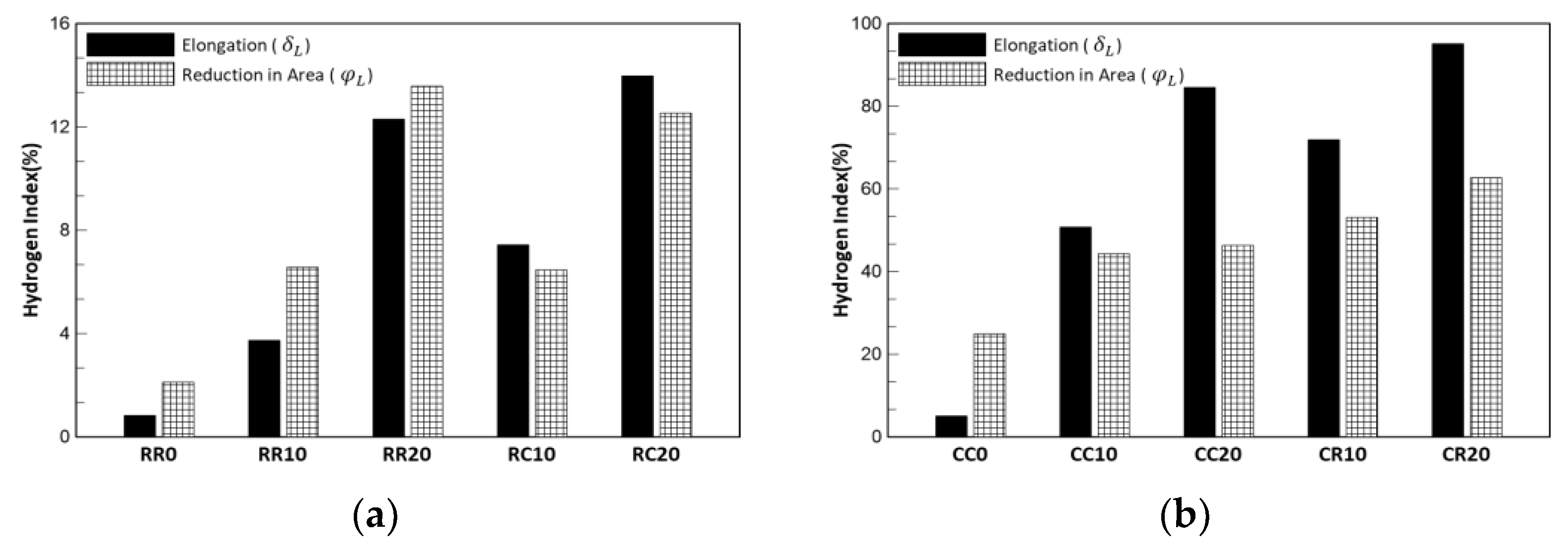
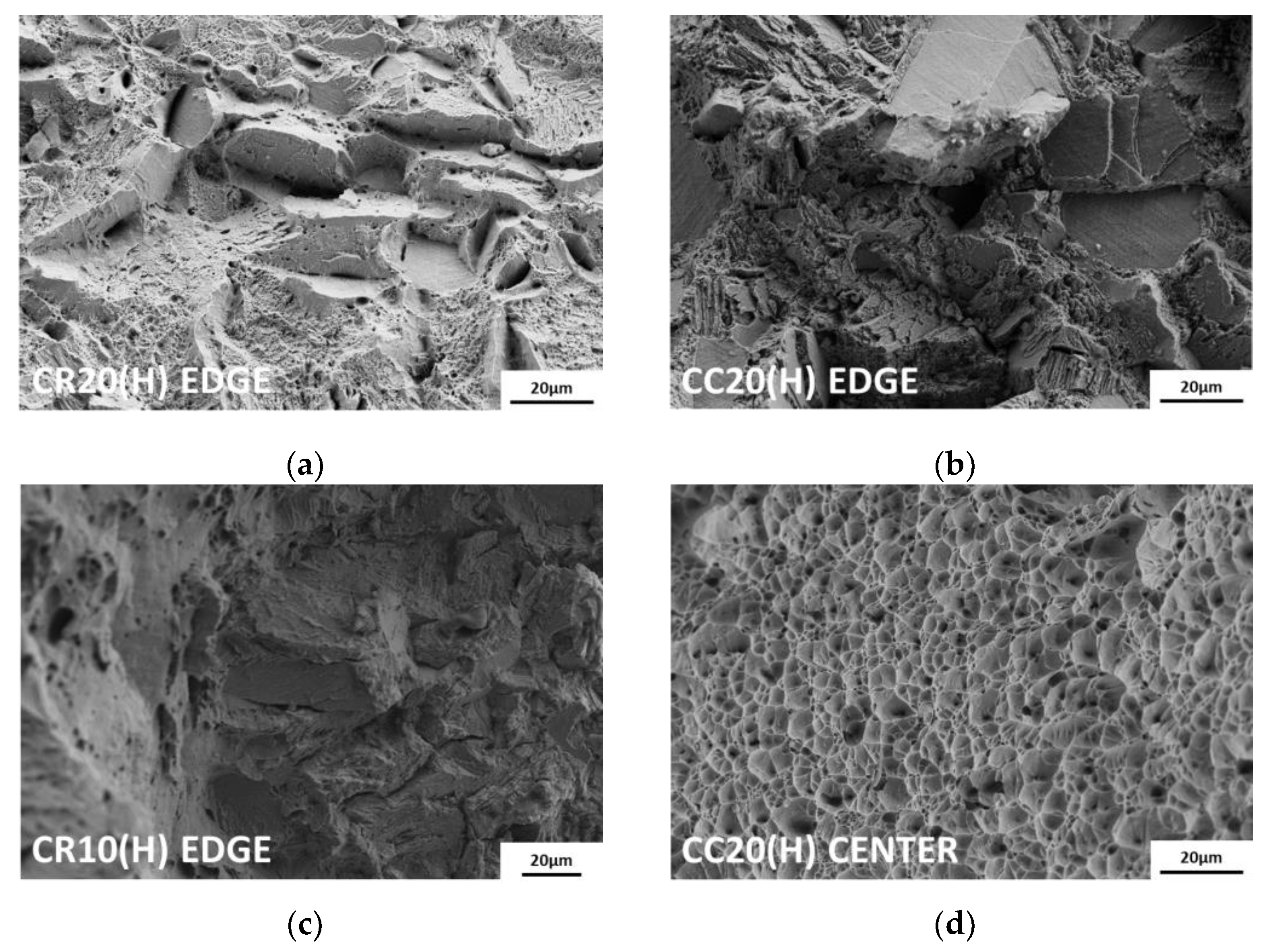
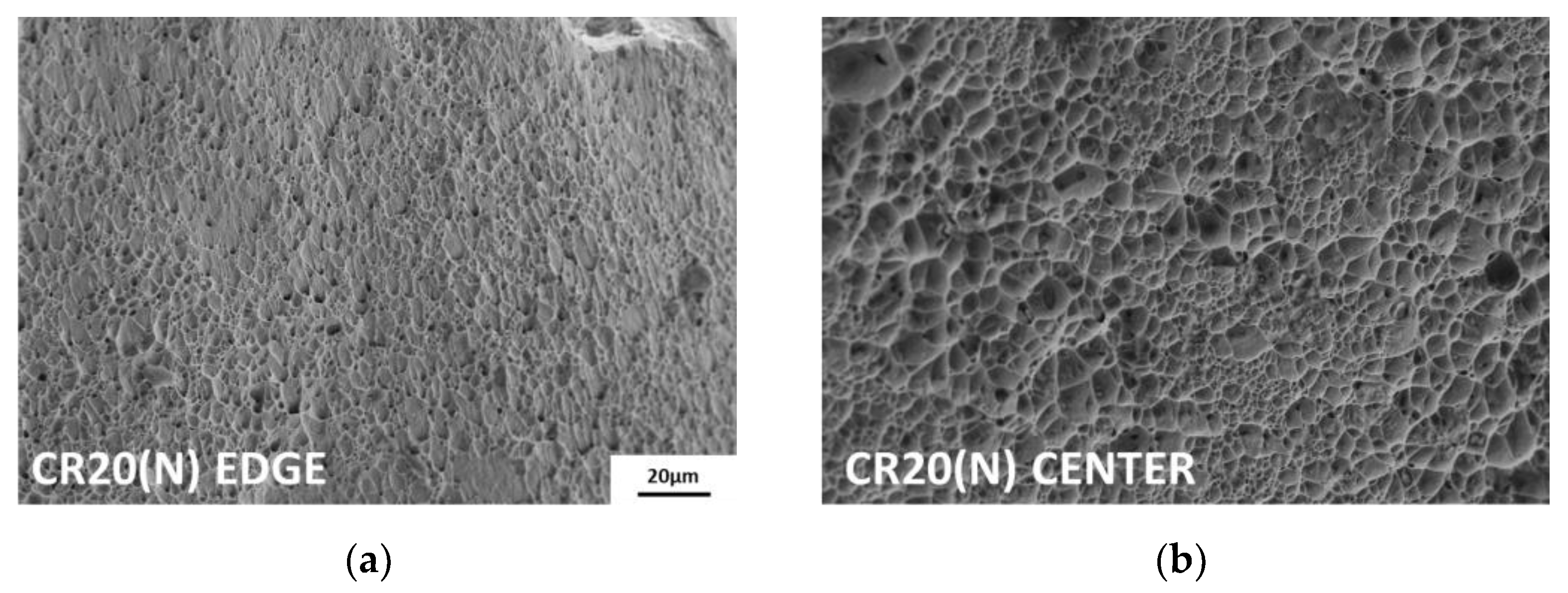
| Composition | C | Si | Mn | P | S | Ni | Cr | Mo | Fe |
|---|---|---|---|---|---|---|---|---|---|
| SUS304L | 0.018 | 0.4 | 1.63 | 0.03 | 0.001 | 8.2 | 18.1 | 0.22 | Bal. |
| Case | Temperature of Prestrain | Degree of Prestrain | Temperature of Tensile Test | Hydrogen Charging |
|---|---|---|---|---|
| 1 | Room Temperature | 0 | Room Temperature | Hydrogen Charging or not |
| 2 | 10 | |||
| 3 | 20 | |||
| 4 | Cryogenic Temperature | 0 | Cryogenic Temperature | |
| 5 | 10 | |||
| 6 | 20 | |||
| 7 | Room Temperature | 10 | Cryogenic Temperature | |
| 8 | 20 | |||
| 9 | Cryogenic Temperature | 10 | Room Temperature | |
| 10 | 20 |
| Prestrain | Non | R 10 | R 20 | C 10 | C 20 |
|---|---|---|---|---|---|
| FCC (%) | 90.86 | 88.30 | 87.87 | 80.93 | 17.89 |
| BCC (%) | 9.14 | 11.70 | 12.13 | 19.07 | 82.11 |
| Temperature | Prestrain | Hydrogen Uncharged | Hydrogen Charged | ||||
|---|---|---|---|---|---|---|---|
| Yield Strength | Tensile Strength | Elongation | Yield Strength | Tensile Strength | Elongation | ||
| (MPa) | (MPa) | (%) | (MPa) | (MPa) | (%) | ||
| RR | Non | 295 | 695 | 65.0 | 298 | 693 | 64.5 |
| 10 | 449 | 705 | 51.9 | 454 | 689 | 50.0 | |
| 20 | 469 | 663 | 41.1 | 490 | 645 | 36.1 | |
| CC | Non | 280 | 1343 | 36.5 | 320 | 1312 | 34.7 |
| 10 | 810 | 1351 | 27.0 | 929 | 1278 | 13.3 | |
| 20 | 1195 | 1344 | 19.5 | 1393 | 1397 | 3.0 | |
| Temperature | Prestrain | Hydrogen Uncharged | Hydrogen Charged | ||||
|---|---|---|---|---|---|---|---|
| Yield Strength | Tensile Strength | Elongation | Yield Strength | Tensile Strength | Elongation | ||
| (MPa) | (MPa) | (%) | (MPa) | (MPa) | (%) | ||
| RC | 10 | 446 | 1267 | 34.4 | 452 | 1248 | 33.3 |
| 20 | 531 | 1180 | 32.2 | 603 | 1112 | 27.7 | |
| CR | 10 | 603 | 945 | 31.0 | 634 | 778 | 8.7 |
| 20 | 1017 | 1080 | 15.7 | - | 948 | 0.8 | |
| RR0(N) | RR0(H) | RR10(H) | RR20(H) | CC0(N) | CC0(H) | CC10(H) | CC20(H) | |
|---|---|---|---|---|---|---|---|---|
| RA | 0.62 | 0.61 | 0.58 | 0.54 | 0.56 | 0.42 | 0.31 | 0.30 |
| RC10(N) | RC10(H) | RC20(N) | RC20(H) | CR10(N) | CR10(H) | CR20(N) | CR20(H) | |
|---|---|---|---|---|---|---|---|---|
| RA | 0.56 | 0.53 | 0.62 | 0.54 | 0.58 | 0.27 | 0.55 | 0.20 |
Disclaimer/Publisher’s Note: The statements, opinions and data contained in all publications are solely those of the individual author(s) and contributor(s) and not of MDPI and/or the editor(s). MDPI and/or the editor(s) disclaim responsibility for any injury to people or property resulting from any ideas, methods, instructions or products referred to in the content. |
© 2022 by the authors. Licensee MDPI, Basel, Switzerland. This article is an open access article distributed under the terms and conditions of the Creative Commons Attribution (CC BY) license (https://creativecommons.org/licenses/by/4.0/).
Share and Cite
Choi, Y.-H.; Lee, J.H.; Kim, S.-M.; Lee, D.-H.; Kim, H.-T.; Kim, J.-H.; Kim, M.; Kim, S.-K.; Lee, J.-M. Temperature-Dependent Hydrogen Embrittlement of Austenitic Stainless Steel on Phase Transformation. Metals 2023, 13, 35. https://doi.org/10.3390/met13010035
Choi Y-H, Lee JH, Kim S-M, Lee D-H, Kim H-T, Kim J-H, Kim M, Kim S-K, Lee J-M. Temperature-Dependent Hydrogen Embrittlement of Austenitic Stainless Steel on Phase Transformation. Metals. 2023; 13(1):35. https://doi.org/10.3390/met13010035
Chicago/Turabian StyleChoi, Young-Hwan, Jung Hee Lee, Seok-Min Kim, Dong-Ha Lee, Hee-Tae Kim, Jeong-Hyeon Kim, Minjung Kim, Seul-Kee Kim, and Jae-Myung Lee. 2023. "Temperature-Dependent Hydrogen Embrittlement of Austenitic Stainless Steel on Phase Transformation" Metals 13, no. 1: 35. https://doi.org/10.3390/met13010035
APA StyleChoi, Y.-H., Lee, J. H., Kim, S.-M., Lee, D.-H., Kim, H.-T., Kim, J.-H., Kim, M., Kim, S.-K., & Lee, J.-M. (2023). Temperature-Dependent Hydrogen Embrittlement of Austenitic Stainless Steel on Phase Transformation. Metals, 13(1), 35. https://doi.org/10.3390/met13010035






